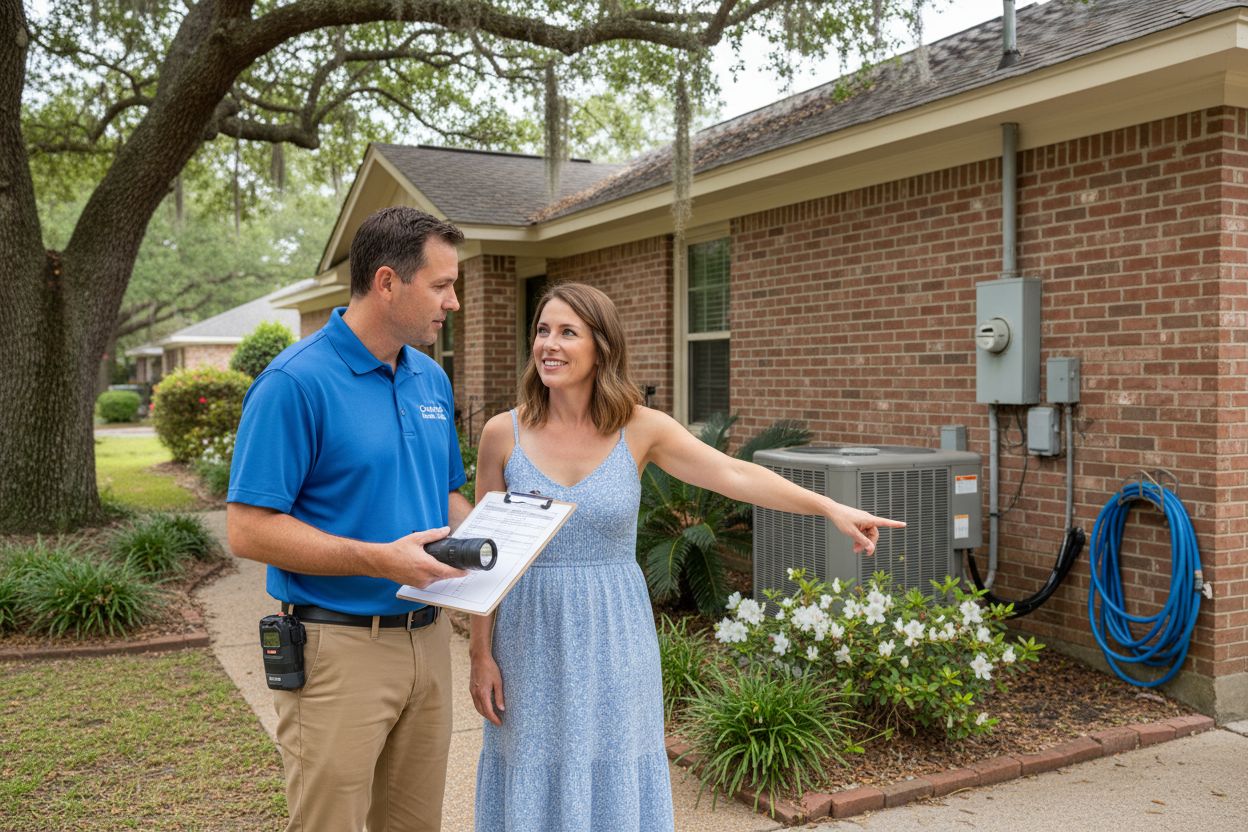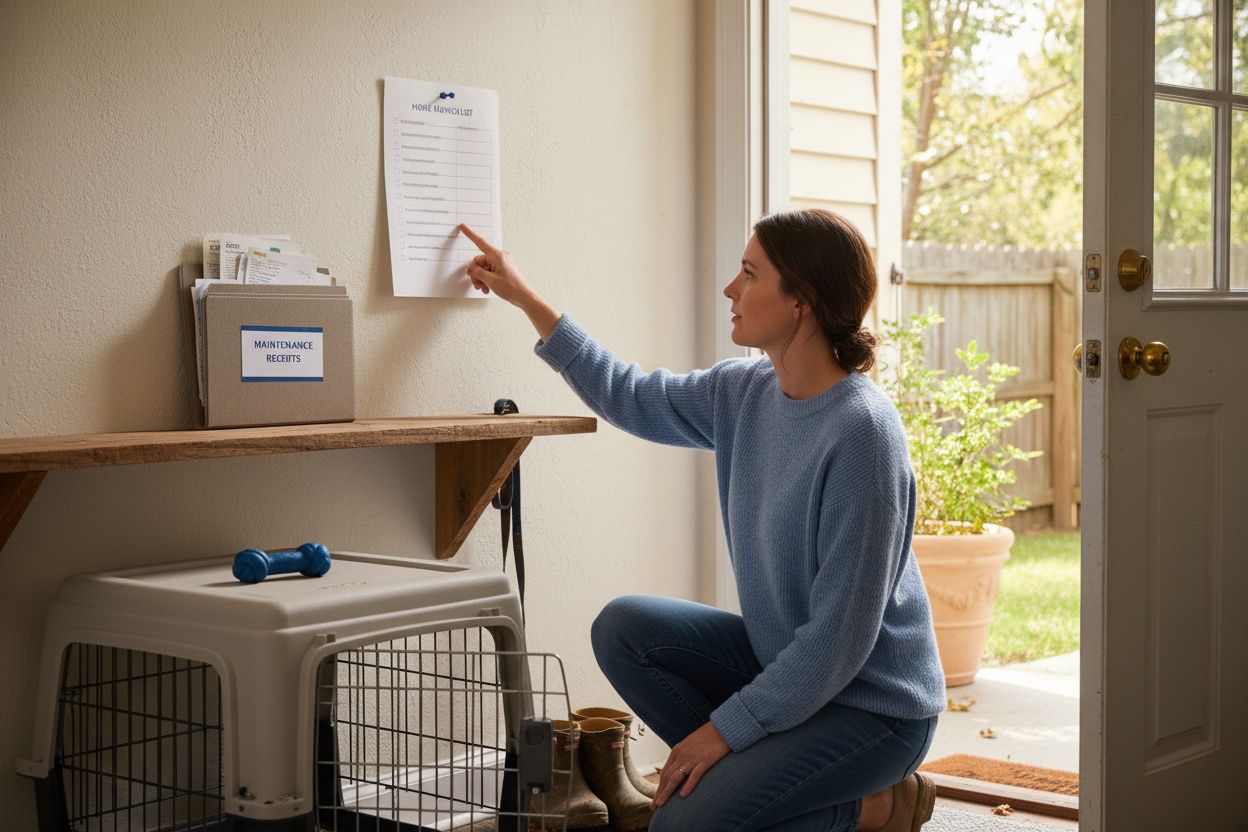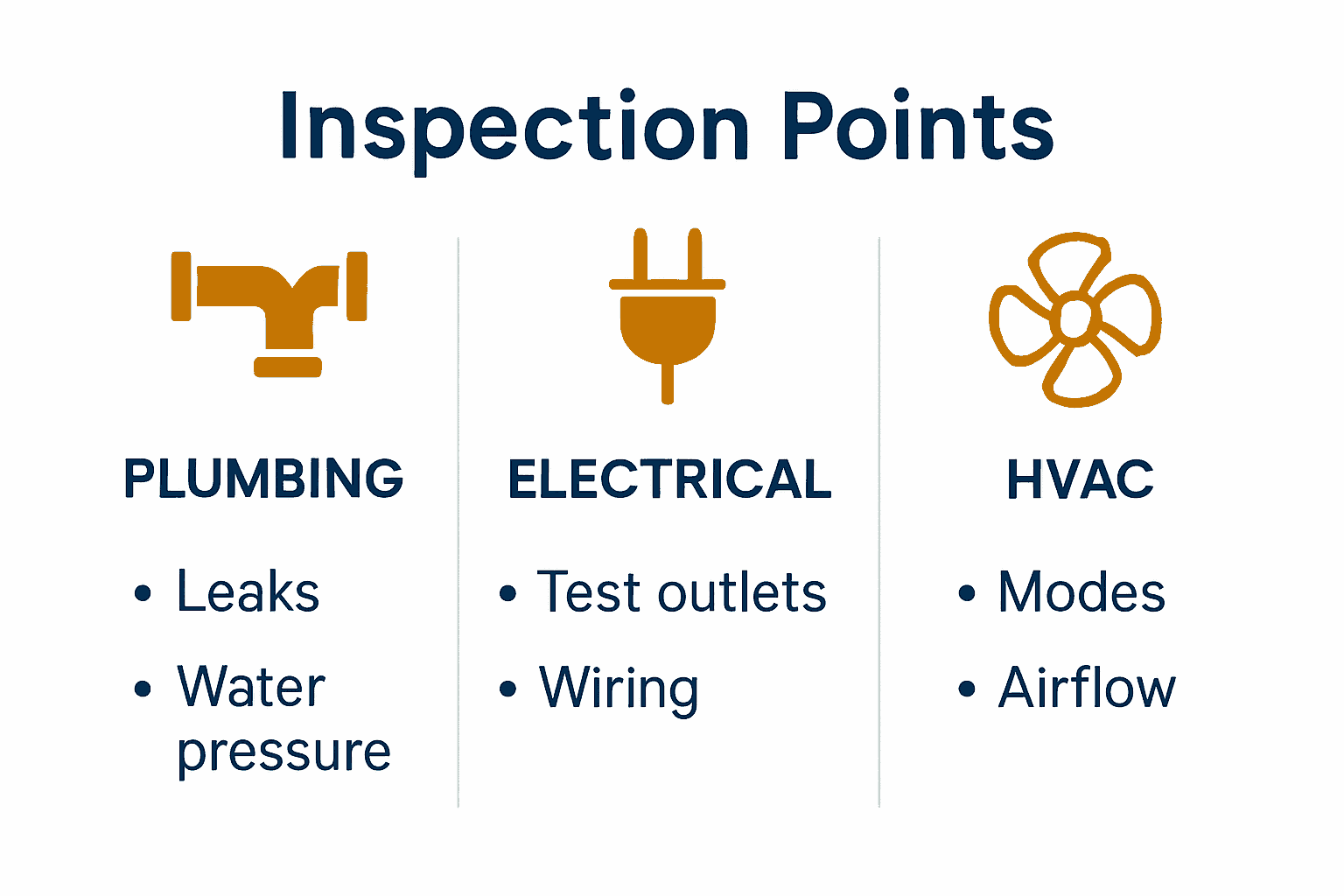Home Maintenance Inspection Guide for Alabama Homes
- Matt Cameron
- Oct 18
- 10 min read
Updated: Nov 3

Over 80 percent of Alabama home sales involve a professional inspection before closing, yet many sellers miss out on simple steps that could make the process smoother and stress free. Preparing for a home inspection can seem overwhelming, especially when every detail matters. By getting organized and tackling key areas before the inspector arrives, you not only ease your stress but also help reveal your property’s true value to buyers.
Quick Summary
Key Point | Explanation |
1. Clear Access for Inspectors | Remove obstacles to utility areas for efficient inspections. This includes furniture blocking panels and ensuring crawl spaces are accessible. |
2. Proactive Exterior Assessment | Examine your home’s exterior surfaces for damage, ensuring proper drainage and grading to prevent water issues. |
3. Thorough Interior Systems Check | Inspect walls, windows, and safety features, ensuring all systems work properly and are well-maintained for safety assurance. |
4. Document and Prioritize Repairs | Create a detailed list of inspection findings and repairs, categorizing them by urgency to maintain home value and safety. |
5. Maintain Comprehensive Records | Keep organized documentation of inspections, repairs, and maintenance to protect your investment and facilitate future sales or claims. |
Table of Contents
Step 1: Prepare Your Home for Inspection
Getting your home ready for a professional inspection might sound daunting, but with the right approach, you can make the process smooth and stress free. Your goal is to help the home inspector access every critical area of your property easily and efficiently.
Start by clearing pathways to all access panels, crawl spaces, and utility areas. According to Alabama’s standards of practice for home inspectors, inspectors need clear access to structural, plumbing, electrical, and HVAC systems. This means moving furniture away from electrical panels, clearing space around water heaters, and ensuring basement or attic entrances are unobstructed.
Special attention should be given to systems that require specific maintenance documentation. Prepare for a thorough home inspection by gathering maintenance records for critical home systems like your septic tank. The Alabama Public Health recommends having effluent filter records and ensuring the entire system is accessible.
Pro Tip: Walk through your home with a critical eye. If you struggle to reach an area, so will your inspector.
Quick organizational steps include:
Collect maintenance receipts for major systems
Unlock any gates or doors leading to exterior inspection areas
Make sure pets are secured or away during the inspection
Have utility bills available to demonstrate system functionality
By taking these preparatory steps, you are setting the stage for a comprehensive and smooth home inspection process. Your proactive approach will help inspectors work efficiently and provide you with the most accurate assessment of your property’s condition.

Step 2: Assess Exterior Structures and Surfaces
Your home’s exterior is its first line of defense against Alabama’s unpredictable weather and potential structural challenges. By carefully assessing exterior structures and surfaces before an inspection, you can identify potential issues and demonstrate proactive home maintenance.
Start with a comprehensive walkthrough of your home’s outer shell. According to Alabama’s home inspection standards, inspectors will meticulously examine wall coverings, flashing, trim, doors, decks, patios, grading, walkways, and drainage systems. This means you should look for signs of wear, damage, or potential water infiltration points.
Learn more about exterior home assessments by paying special attention to key areas. Check exterior wall coverings for cracks, loose siding, or areas where moisture might penetrate. Inspect trim around windows and doors for signs of rot or separation. Look closely at deck attachments and ensure they appear secure and well maintained.
Grading and drainage are critical components of exterior assessment. The Alabama Department of Environmental Management emphasizes the importance of managing exterior runoff to prevent water damage. Walk around your property and observe how water flows during or after rain. Ideally, the ground should slope away from your home’s foundation, preventing water accumulation that could cause structural issues.
Pro Tip: Water should always flow away from your home. If you notice pooling near the foundation, consider regrading or installing additional drainage solutions.
Quick exterior assessment checklist:
Examine wall surfaces for cracks or damage
Check exterior paint and siding condition
Inspect roof edges and flashing
Verify deck and patio structural integrity
Assess ground slope around foundation
By conducting a thorough exterior evaluation, you demonstrate responsible homeownership and help your inspector identify potential concerns before they become significant problems. Your proactive approach will provide peace of mind and potentially save you from costly future repairs.
Step 3: Evaluate Interior Systems and Safety
Preparing for a comprehensive home inspection means diving deep into your home’s interior systems and safety features. Your goal is to identify potential issues and demonstrate that your living spaces are well maintained and secure.
State inspection standards require a thorough evaluation of interior components. This means carefully examining walls, ceilings, floors, stairs, doors, windows, and garage doors for structural integrity and potential safety risks. Walk through each room with a critical eye, looking for signs of damage, uneven surfaces, or areas that might compromise your home’s safety.
Learn more about essential home safety features and pay special attention to critical systems. According to Alabama’s Division of Risk Management, HVAC systems and fire prevention are paramount. Check your heating and ventilation systems for proper maintenance. Ensure that smoke detectors are functioning, fire extinguishers are accessible, and potential fire hazards are minimized.
Focus on key interior safety aspects:
Here’s a comparison of key interior systems to check during your inspection:
System/Area | What to Inspect | Why It Matters |
Walls, Ceilings, Floors | Look for cracks, stains, or damage | Reveals structural issues |
Windows & Doors | Test locks Check operation | Security & functionality |
Stairs & Railings | Ensure stability | Prevents injury risks |
Smoke Detectors | Test functionality | Critical for fire safety |
Garage Doors | Test sensors Check operation | Safety & property access |
HVAC System | Check heating & cooling modes | Air quality & comfort |
Test all electrical outlets for proper function
Check window and door locks for security
Inspect stairs and railings for stability
Look for signs of water damage or mold
Verify that garage doors operate smoothly and have proper safety sensors
Pro Tip: Open and close every door and window. They should move smoothly without sticking or requiring excessive force.
By methodically assessing your home’s interior systems, you demonstrate responsible homeownership and help your inspector identify potential concerns before they become significant problems. Your proactive approach ensures a smoother inspection process and provides peace of mind about your home’s overall condition.
Step 4: Inspect Plumbing, Electrical, and HVAC Units
As you prepare for a comprehensive home inspection, understanding the critical systems that keep your Alabama home running smoothly is essential. Your goal is to ensure that plumbing, electrical, and HVAC units are functioning safely and efficiently.
Alabama’s inspection standards require a detailed examination of these core home systems. This means carefully reviewing water supply lines, waste systems, electrical conductors, and heating and cooling equipment. Start by checking visible plumbing components for signs of leaks, corrosion, or improper installation. Look under sinks, around toilets, and near water heaters for any moisture or water damage.
Learn how to maintain your HVAC system and ensure optimal performance. According to the Alabama Board of Heating, Air Conditioning & Refrigeration Contractors, maintaining proper documentation of system inspections and repairs is crucial. Test your HVAC system by running both heating and cooling modes, listening for unusual sounds and checking for consistent temperature distribution.
Electrical system assessment requires careful attention. Check your electrical panel for any signs of wear, ensure circuit breakers are labeled correctly, and verify that there are no exposed wires or improper connections. Test outlets using a simple outlet tester to confirm proper grounding and functionality.
Pro Tip: Check the age and condition of your water heater. Units over 10 years old may need replacement and can be a potential inspection red flag.
Key areas to focus on during your inspection:
Examine plumbing for leaks and water pressure
Test all electrical outlets and switches
Verify HVAC system performance in both heating and cooling modes
Check water heater condition and age
Look for proper ventilation in all systems

By proactively assessing these critical home systems, you demonstrate responsible homeownership and help your inspector identify potential concerns before they become significant problems. Your thorough approach ensures a smoother inspection process and provides peace of mind about your home’s essential infrastructure.
Step 5: Document Issues and Schedule Repairs
After a thorough home inspection, transforming identified issues into actionable repairs requires strategic planning and careful documentation. Your goal is to create a comprehensive repair strategy that addresses potential problems while protecting your home’s value and safety.
Inspectors are required to report significant deficiencies and recommend corrective actions. This means carefully reviewing your inspection report and categorizing issues by priority. Critical problems requiring immediate attention should be addressed first, while minor cosmetic concerns can be scheduled for later repair.
Discover how to build an effective repair report and manage your home maintenance effectively. According to the Alabama Home Builders Licensure Board, documentation is key when scheduling repairs. Create a detailed spreadsheet or digital record that includes:
Specific location of each issue
Detailed description of the problem
Estimated repair complexity
Potential contractor recommendations
Projected repair costs
When selecting contractors, the Alabama Home Builders Licensure Board strongly advises hiring licensed professionals. This ensures that repairs meet local building codes and safety standards. Request multiple quotes, check contractor references, and verify their licensing status before committing to any repair work.
Pro Tip: Photograph each identified issue before repairs begin. These images can serve as valuable documentation for insurance and future reference.
Prioritize repairs based on safety, structural integrity, and potential for further damage. Issues affecting your home’s fundamental systems like plumbing, electrical, or structural components should be addressed quickly to prevent more expensive problems down the line.
By methodically documenting and addressing inspection findings, you demonstrate responsible homeownership and protect your property investment. Your proactive approach will help maintain your home’s value and ensure a safe, comfortable living environment.
Step 6: Verify Inspection Results and Maintain Records
Congratulations on completing your home inspection journey. The final crucial step involves carefully verifying inspection results and creating a robust system for maintaining comprehensive home maintenance records. Your goal is to protect your property investment and create a valuable documentation trail for future reference.
Alabama Public Health strongly recommends maintaining detailed records for all home systems. This means creating a dedicated digital or physical folder that includes your complete home inspection report, all repair documentation, maintenance logs, and professional service records. Think of this as your home’s medical history a comprehensive record that tracks its health and evolution over time.
Explore effective record keeping strategies for long term home maintenance. According to the HVAC contractors board, retaining documentation is critical for resolving potential future disputes and tracking warranty information. Create a systematic approach to organizing your records:
Original home inspection report
Repair estimates and completed work invoices
Contractor contact information
Maintenance service logs
Warranty documentation for major systems
Pro Tip: Scan and digitally backup all physical documents. Store copies in both cloud storage and a physical fireproof location.
Verify that all recommended repairs from the initial inspection have been completed correctly. This means reviewing before and after photographs, checking repair quality, and ensuring that licensed professionals performed the work according to local building standards.
By meticulously maintaining your home’s documentation, you are not just preserving records but creating a valuable asset. These records can help during future sales, insurance claims, and provide peace of mind about your property’s condition and maintenance history.
Ready for a Home Inspection Experience You Can Trust?
You have taken the right steps by following the Home Maintenance Inspection Guide for Alabama Homes. But even when you clear pathways, check systems, and organize your records, uncertainty can linger. Will a missed detail cost you later? Are your inspection results truly comprehensive? These concerns are common among Alabama homeowners, especially when stakes are high during a sale or purchase.
At Trinity Home Inspections, we remove that worry.

Choose a locally trusted team rooted in honesty, faith, and a genuine commitment to your peace of mind. We deliver thorough, unbiased reports and guide you through every step, from detailed exterior and interior reviews to clear documentation for repairs. Want to learn more about what really makes a professional inspection stand out? Explore our recent home inspection insights and see why buyers and sellers across the Gulf Coast rely on us. Visit Trinity Home Inspections today, book your inspection, and ensure your property is protected by expertise you can trust.
Act now while your questions are fresh. Let us help you make the next move with confidence.
Frequently Asked Questions
How do I prepare my home for a maintenance inspection?
To prepare your home for a maintenance inspection, clear access to all critical areas, including crawl spaces and utility panels. Make sure to move furniture away and secure any pets to ensure the inspector can work efficiently.
What should I look for during an exterior assessment of my home?
During an exterior assessment, examine wall coverings for cracks, check drainage systems, and inspect decks for stability. Identify any signs of water accumulation around the foundation and note any areas needing repairs.
How can I evaluate my home’s interior safety systems?
To evaluate your home’s interior safety systems, check smoke detectors, test doors and windows, and inspect stairs for stability. Ensure that all safety features are functioning properly and repair any issues to enhance overall home safety.
What critical systems should I focus on during the inspection?
Focus on inspecting plumbing for leaks, testing electrical outlets, and assessing HVAC performance. Pay attention to the condition of the water heater and ensure that all systems are functioning efficiently before the inspection.
How should I document issues found during the inspection?
Document issues by creating a detailed log that describes the problems, their locations, and any recommended repair actions. This documentation will help you prioritize repairs and maintain your home’s value over time.
What type of records should I maintain after the inspection?
Maintain records that include the home inspection report, repair invoices, and maintenance logs. Organize this information in a dedicated folder to create a comprehensive history of your home’s maintenance and repairs.
Recommended

